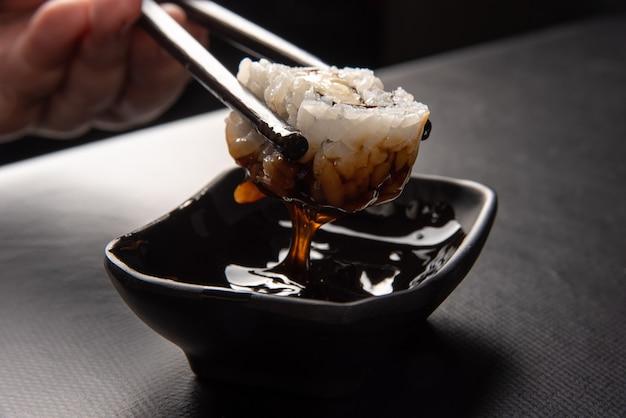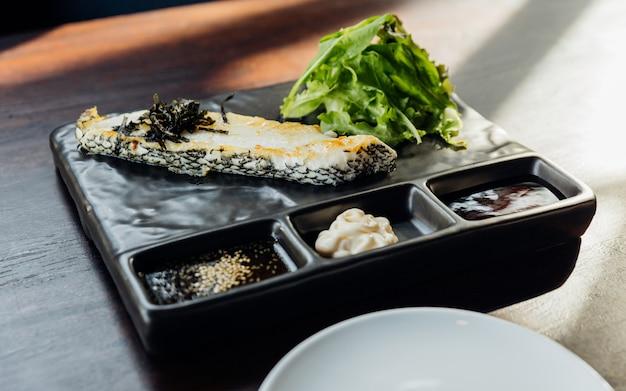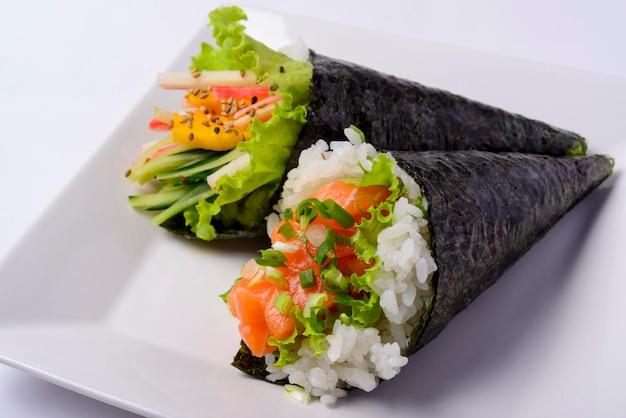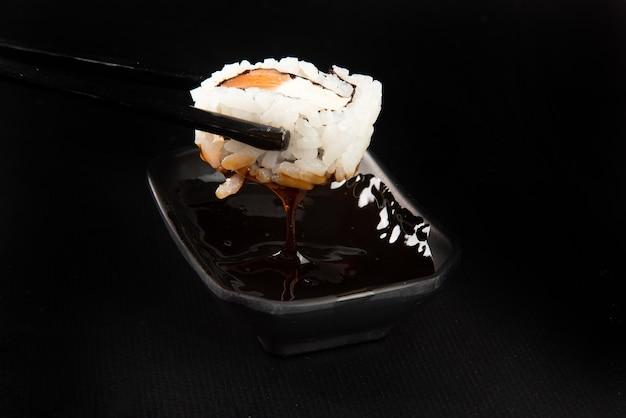Are you a ramen enthusiast? If so, you’ve probably come across the term “tare” in your quest for the perfect bowl of noodles. But what exactly is tare? And why is it such an essential component of a delicious bowl of ramen? In this blog post, we will delve into the world of shoyu tare, one of the most popular types of ramen seasoning, and uncover its secrets. Whether you’re a seasoned ramen aficionado or just discovering the wonders of this Japanese comfort food, understanding shoyu tare will take your ramen game to the next level. So, grab your chopsticks and let’s dive in!
Shoyu Tare: The Secret Sauce Behind Perfect Ramen
If you’re a ramen fanatic like me, you know that the key to a bowl of heavenly goodness lies in the broth. But it’s not just any old broth that makes the cut – it’s the shoyu tare that takes it to another level. So, buckle up and let’s dive into the world of shoyu tare!
What is Shoyu Tare
Tare, pronounced tah-ray, is the essential flavoring agent that gives ramen its distinct taste. Among the various types of tare, shoyu tare is a rockstar in the ramen world. Shoyu, meaning soy sauce, brings a unique umami flavor to the table and adds a touch of savory goodness to the broth.
The Perfect Combination of Savory and Salty
When it comes to creating the perfect balance of flavors in shoyu tare, it’s essential to find that sweet spot between savory and salty. Too much salt and your taste buds might throw a fit, but skimp on it, and you’ll be left with a lackluster bowl of ramen. It’s a delicate dance that any ramen chef must master.
The Magical Lineup of Ingredients
Shoyu tare is more than just soy sauce. It’s a harmonious blend of carefully selected ingredients that work their magic together. Soy sauce forms the foundation, and then comes mirin, a sweet rice wine, to add a touch of sweetness. Sake, another type of rice wine, brings depth and complexity to the mix. Finally, a dash of sugar to round out the flavors and create that irresistible umami explosion.
The Art of Balancing Flavors
Creating shoyu tare is an art form that requires precision and careful consideration. As the saying goes, “Too much of a good thing can be a bad thing.” A skilled ramen chef knows just how to strike that delicate balance to make the flavors sing. It’s a dance between salty and sweet, savory and umami, bringing together a beautiful symphony of taste.
Homemade vs. Store-Bought
Now, you might be wondering if you should try your hand at making shoyu tare at home or simply opt for the convenience of a store-bought version. While both have their merits, there’s something special about creating your own flavor masterpiece. Plus, you have the flexibility to fine-tune the proportions to suit your taste buds precisely.
Time to Level Up Your Ramen Game
Now that you’re armed with the knowledge of shoyu tare, it’s time to level up your ramen game. The next time you slurp a bowl of steaming ramen, take a moment to appreciate the symphony of flavors dancing in the broth – all thanks to the magnificent shoyu tare.
So, gather your ingredients, put on your chef’s hat, and embark on an adventure to create the perfect shoyu tare. Trust me, your taste buds will thank you!
Miso Tare: The Flavorsome and Savory Twist for Your Shoyu Tare
Move over, shoyu tare, because there’s a new kid on the block – miso tare. This umami-packed sauce is the perfect companion to your beloved ramen bowls. Bursting with savory flavors and a hint of sweetness, miso tare adds a delightful twist to your noodle soup experience.
What is Miso Tare
Miso tare is a Japanese sauce made from fermented soybeans, rice or barley, salt, and koji. This thick and rich paste is often used as a seasoning in Japanese cuisine, but its versatility shines when it meets a bowl of steaming ramen. With its earthy and complex flavors, miso tare takes your ramen to a whole new level of deliciousness.
The Many Faces of Miso Tare
Unlike shoyu tare, which relies on soy sauce, miso tare offers a wide range of flavor profiles to suit every taste. From the mellow and sweet white miso to the more robust and intense red miso, miso tare opens a world of possibilities for your ramen creations.
Finding the Perfect Balance
To achieve the perfect balance of flavors in your miso tare, it’s essential to experiment with different ingredients. Enhance the umami goodness by adding a dash of sake or mirin. Alternatively, give it a little kick with a touch of chili oil or sesame paste. Let your taste buds guide you as you embark on a miso tare adventure!
Boosting Your Ramen Game
By incorporating miso tare into your ramen recipe, you’re taking your culinary skills to new heights. Amp up the complexity of your broth by adding miso tare at various stages of the cooking process. Whether you choose to mix it in at the beginning or swirl it in just before serving, miso tare infuses your ramen with an explosion of flavors that will leave you craving more.
Miso Tare: The Umami All-Star
While shoyu tare has its own charm, miso tare brings a unique umami profile to the table. With its depth of flavors and versatility, miso tare is bound to become your new secret weapon in the kitchen. So, go ahead, get creative, and let the miso tare elevate your ramen game to a whole new level of yum!
There you have it – the scoop on miso tare and how it can add a delectable twist to your beloved ramen bowls. Give it a try, and watch as your taste buds dance with delight. Sayonara, ordinary ramen – miso tare is here to take the spotlight!
Ramen Tare Recipe
Have you ever wondered what makes a bowl of ramen taste so incredible? Well, my friend, let me introduce you to the secret behind the magic: ramen tare. This little gem of a condiment is what brings the flavors of the ramen broth to life. It’s like the superhero sidekick that takes an already delicious dish and turns it into a culinary masterpiece. So today, I’m going to spill the beans (or should I say, soy sauce) and share with you a killer ramen tare recipe that will catapult your homemade ramen game to new heights.
What is Ramen Tare, Anyway
Before we dive into the nitty-gritty of the recipe, let’s first understand what ramen tare really is. Put simply, ramen tare is a concentrated flavoring sauce that’s added to the ramen broth. It’s typically made from a combination of soy sauce, mirin, sake, and other flavor enhancers like garlic, ginger, and even fish. But here’s the thing: there’s no one-size-fits-all recipe for ramen tare. Every ramen shop has its own secret formula, its own special blend of flavors that makes its broth stand out from the rest. So why should you be left behind? Let’s create our own ramen legacy!
The Ingredients: Unleashing Flavor Bombs
To create an epic ramen tare, you’ll need the following ingredients:
- Soy Sauce: Use a high-quality soy sauce to achieve that umami explosion.
- Mirin: This sweet rice wine adds a touch of sweetness and depth to the tare.
- Sake: The unsung hero that brings out the hidden flavors in the broth.
- Garlic and Ginger: Give your tare some zing with these aromatic powerhouses.
- Fish Sauce: Brace yourself, because this secret ingredient will take your taste buds on a wild ride.
- Spring Onions: Chop ’em up and let them work their magic.
The Method: Unlocking the Flavor Vault
- Mix It Up: In a small saucepan, combine soy sauce, mirin, and sake. Use a 2:1:1 ratio for a balanced flavor.
- Bring Out the Aromatics: Add minced garlic and grated ginger to the saucepan and let the mixture simmer over low heat. Take a moment to savor the delightful fragrance wafting through your kitchen.
- Fishy Business: It’s time to introduce fish sauce to the mix. Start with a small amount and gradually add more to suit your taste. Be warned, though – a little goes a long way.
- Spring into Action: Throw in a handful of chopped spring onions and simmer the tare for a few more minutes until all the flavors have mingled perfectly. Don’t be surprised if you find yourself drooling uncontrollably at this point.
The Moment of Truth: Pouring Perfection
Now that your ramen tare is ready, it’s time to unveil its true potential. Take a ladleful or two of your favorite homemade or store-bought ramen broth into a separate bowl. Add a spoonful of your gloriously flavorful tare and give it a stir. Taste it. Feel the explosion of flavors on your palate. Congratulations, my friend – you’ve just created a ramen symphony that would make even the most discerning taste buds weak at the knees.
Final Words: A Journey of Flavor and Fun
And there you have it, folks – a recipe for ramen tare that will transport your taste buds straight to flavor nirvana. Play around with the ingredients, adjust the proportions, and make it your own. This is your chance to unleash your inner ramen maestro and create unforgettable bowls of goodness. So go forth, my friend, and may your ramen adventures be brimming with flavor, laughter, and a whole lot of slurping.
Shoyu Tare Meaning
If you’re a fan of Japanese cuisine, you’ve probably come across the term “shoyu tare” on menus or cooking shows. But what the heck does it actually mean? Well, my friend, let me break it down for you in a way that will make you want to grab a bowl of ramen right away.
The Basics: Soy Sauce on Steroids
Shoyu, which literally means “soy sauce” in Japanese, is the star of the show here. But this ain’t your average soy sauce, oh no. Shoyu tare is a flavor-packed concoction that takes soy sauce to a whole new level. It’s like regular soy sauce on steroids, with extra umami powers and a touch of magic.
Unveiling the Umami Bomb
Okay, let’s get a bit technical here. Shoyu tare is essentially a rich, umami-laden sauce made by combining soy sauce, mirin (a sweet rice wine), sake (Japanese rice wine), and sometimes other secret ingredients. It’s a flavor bomb that hits your taste buds with a punch of savory goodness. Just a small drizzle of this liquid gold can transform a plain bowl of noodles into a culinary masterpiece.
The Building Blocks of Flavor
At its core, shoyu tare is all about balance. It brings together the five basic tastes: salty, sweet, sour, bitter, and umami. Each ingredient plays a crucial role in creating the perfect harmony of flavors. The soy sauce adds that salty umami kick, while the mirin and sake provide a hint of sweetness and depth. Some chefs even add garlic, ginger, or other aromatic ingredients to further enhance the taste profile.
A Versatile Flavor Enhancer
Shoyu tare is not just limited to ramen bowls; it’s a versatile flavor enhancer that can level up a variety of dishes. You can use it as a marinade for grilled meats, a dipping sauce for sushi or dumplings, or even as a seasoning for stir-fried vegetables. The possibilities are endless, my friend!
Crafting Your Own Shoyu Tare
Now, here’s a fun challenge for you: why not try making your own shoyu tare at home? Experiment with different ratios of soy sauce, mirin, and sake until you find the perfect balance of flavors that suits your taste buds. Feel free to get creative and add your own unique twist with spices or other ingredients. Remember, cooking is all about enjoying the journey and discovering new flavors along the way.
So, the next time you see “shoyu tare” on a menu, you’ll know exactly what it means. It’s not just another fancy term; it’s the secret sauce that adds a burst of umami to your favorite Japanese dishes. So go ahead, embrace the culinary magic and give that shoyu tare a try. Your taste buds will thank you!
Best Tare for Tonkotsu
Tonkotsu ramen is a rich, creamy, and indulgent noodle dish that has become a favorite among ramen lovers worldwide. It’s all about that perfectly cooked pork belly, those melt-in-your-mouth chashu slices, and those thick, chewy noodles. But let’s not forget about the unsung hero that ties it all together – the tare. And when it comes to tonkotsu, you need a tare that can hold its own against that robust broth.
Unleash the Flavor Fury with Shoyu Tare
Shoyu tare, a soy-based seasoning sauce, is the perfect partner in crime for tonkotsu ramen. Its salty, umami-packed profile adds depth and complexity to the already rich broth. The combination of soy sauce, mirin, and other secret ingredients creates a potent concoction that will leave your taste buds doing a happy dance. It’s the flavor bomb that makes your tonkotsu truly next-level.
A Symphony of Savory Notes
The best tare for tonkotsu strikes a delicate balance between saltiness, sweetness, and deep umami flavors. It should enhance the already robust pork broth without overpowering it. Shoyu tare accomplishes just that. Its savory notes complement the natural richness of the tonkotsu base, elevating each spoonful to new heights of deliciousness.
Secret Ingredients, Secret Weapon
What makes shoyu tare so special? It’s all about the secret ingredients. While each ramen chef has their own unique recipe, common additions to shoyu tare include garlic, ginger, bonito flakes, and sometimes even a touch of smoky bonito oil. These elements lend complexity and depth to the tare, creating a symphony of flavors that harmonize with the tonkotsu broth.
The Magic of Marinating
One of the secrets to achieving a truly exceptional shoyu tare is allowing it to marinate. This magical process helps the flavors meld together, creating a sauce that is greater than the sum of its parts. So, give it some time to work its magic. Patience is key, my ramen-loving friend.
A Word on Adjustments
Remember, taste is subjective, and what works for one person might not work for another. The beauty of shoyu tare is its adaptability. Feel free to play around with different ratios and ingredients until you find your perfect balance. After all, the best tare for tonkotsu is the one that makes your taste buds sing.
So, my ramen aficionados, don’t overlook the importance of a good tare when it comes to tonkotsu ramen. The right shoyu tare can take your bowl of goodness from great to phenomenal. Its salty, savory, and umami-packed flavors will dance on your tongue and leave you craving for more. So, next time you slurp on that bowl of tonkotsu ramen, remember to raise a chopstick in honor of the humble tare. It’s the unsung hero that makes the magic happen.
What is Shoyu Tare Made Of
Shoyu tare is the essential flavoring component in traditional soy sauce-based ramen. This heavenly concoction is a key player in elevating the overall umami-packed experience of a bowl of ramen. So, what exactly goes into making this magical elixir?
Soy Sauce: The Star of the Show
Unsurprisingly, the main ingredient of shoyu tare is soy sauce. But not just any soy sauce – typically, a high-quality, artisanal soy sauce is used to create the perfect balance of flavors. This dark, savory liquid is made from fermented soybeans, roasted grains, water, and salt. It undergoes a meticulous brewing process that can take months to years, resulting in a complex umami profile that dances on your taste buds.
Mirin: The Sweet Sidekick
Adding a touch of sweetness to the mix, mirin comes into play. Mirin is a sweet Japanese rice wine that lends a subtle depth of flavor to the shoyu tare. It helps counterbalance the saltiness of the soy sauce, further enhancing the overall harmony of the dish. Just like a good sidekick in a buddy cop movie, mirin knows exactly when and how to support its partner without stealing the spotlight.
Sake: The Boozy Buddy
To boost the umami and impart a slight alcoholic kick, sake comes into play. This Japanese rice wine is not only enjoyed on its own but also plays a crucial role in the creation of shoyu tare. The yeast fermentation process of sake production creates a range of flavors, resulting in a delightful complexity that enhances the overall depth of the sauce. Sake brings a touch of elegance and a dash of camaraderie to the shoyu tare party.
Bonito Flakes: The Fishy Secret
Hold your breath, because there’s a secret fishy ingredient in shoyu tare – bonito flakes. These delicate, dried, and fermented flakes are derived from bonito fish, a type of tuna. Don’t worry; it’s not going to turn your ramen into a seafood extravaganza. The umami-rich bonito flakes lend a subtle fishy undertone that adds an extra layer of depth to the sauce, resulting in a symphony of flavors that’ll make your taste buds tango.
Kombu: The Oceanic Oomph
Completing the ensemble is kombu, a type of dried kelp. Don’t underestimate this unassuming algae; it’s the secret ingredient that gives the shoyu tare its oceanic oomph. Kombu infuses the sauce with a gentle hint of umami and enriches the overall flavor profile. It’s like a wise old sage – humble, yet essential.
In conclusion, shoyu tare is a delectable blend of soy sauce, mirin, sake, bonito flakes, and kombu. Together, they form the dynamic flavor base that makes a bowl of ramen truly unforgettable. So, next time you slurp down some ramen, remember the hidden heroes behind the scenes, working tirelessly to bring joy to your taste buds.
What Does Tare Mean in Ramen
Ramen lovers, listen up! If you’ve ever slurped down a delicious bowl of ramen and wondered about the magical flavor that sets it apart, then you’ve stumbled upon a bowl with a remarkable tare. But what exactly does tare mean in ramen? Buckle up, and let’s dive into the salty and savory secrets of this game-changing ingredient.
Unraveling the Secrets of Tare
In the world of ramen, tare is the soul that gives the broth its character. Think of it as the seasoning that adds that extra oomph to each mouthful of noodles. Tare is a concentrated sauce that’s responsible for the bold, umami-packed flavors that harmonize with the richness of the broth.
Tare: The Symphony Conductor
When it comes to ramen, tare plays a vital role as the symphony conductor of flavors. It sets the tone for the entire dish. Whether it’s a soy-based, miso-based, or salt-based tare, it acts as the flavor foundation that transforms a simple bowl of noodles into a culinary masterpiece.
A Flavor Bomb in Every Sip
Picture this: you take a sip of the broth, and the flavors explode on your taste buds like fireworks on the Fourth of July. That explosion of flavors is all thanks to the tare. It infuses the broth with complexity and depth, ensuring that each mouthful is a flavor bomb waiting to happen. It’s the reason why ramen is so addictive and leaves you craving for more.
Tantalizing Trio: Soy-Based, Miso-Based, and Salt-Based Tare
Now that we’ve got the basics covered, let’s take a closer look at the three main types of tare and what sets them apart.
Soy-Based Tare: A Classic Favorite
Soy-based tare, also known as shoyu tare, takes the spotlight as one of the most popular choices. Made from soy sauce, this tare brings a harmonious balance of saltiness and umami to the ramen bowl. It’s the quintessential choice for those seeking a traditional ramen experience with a hint of nostalgia.
Miso-Based Tare: Funky and Fermented
For those looking for a bolder and more adventurous flavor, miso-based tare is the way to go. This tare gets its unique taste from fermented soybean paste. Its funky and complex flavor profile adds an intriguing depth that takes your taste buds on a wild ride. So, buckle up and prepare for a flavor explosion!
Salt-Based Tare: Simple Yet Mighty
If you prefer a lighter and more delicate flavor, then salt-based tare is your best bet. As the name suggests, this tare relies on salt to enhance the broth without overpowering it. It’s a great option for those who appreciate the subtle nuances of the broth, allowing the other ingredients to shine.
In the End, It’s All about Balance
When it comes down to it, tare is the secret ingredient that brings harmony and balance to a bowl of ramen. Whether it’s the soy-based, miso-based, or salt-based variety, tare marries the flavors in the broth, noodles, and toppings, creating a symphony of flavors that will leave you craving more.
So, the next time you indulge in a steaming bowl of ramen, take a moment to appreciate the tare. It’s the unsung hero that elevates this humble dish and turns it into a culinary masterpiece. Remember, friends, ramen without tare is like a concert without music – it just doesn’t hit the right notes!



